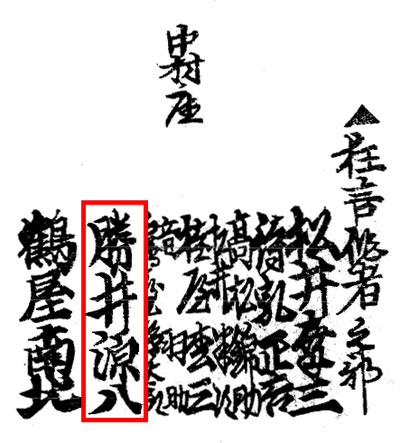| KATSUI GEMPACHI |
|
Pen names:
Existence: 1778 ~ 21st day of the 1st lunar month of 1828 [1] Connection: Master: Tsuruya Nanboku IV Career: 1778: born in Urawa-shuku [2], a station on the Nakasend˘. Beginning of the Bunka era: he becomes a disciple of Katsu Hy˘z˘ I, who gives him the name of Katsu Hidez˘. He switches to Katsu Danz˘ at unknown times. 11th lunar month of 1810: he takes the name of Katsuura Shűz˘ (in fact it is his real name!) and works with his master at the Ichimuraza on the kaomise drama "Shitenn˘ Yagura no Ishizue"; for the first time his name appears on a theater playbill. 11th lunar month of 1816: he takes the name of Katsui Genhachir˘ and works with his master, Sakurada Jisuke II and Segawa Jok˘ II at the Kawarasakiza on the kaomise drama "Kiyomori Eiga no Utena", which also celebrates the shűmei of S˘ry˘ Jinroku II, ďtani Bajű II, Sakata Hanjűr˘, Band˘ Matajűr˘ III, Ichikawa Momotar˘ I, Tsuuchi Monzabur˘ III and Ichikawa Kodanji III. 3rd lunar month of 1817: premiere at the Kawarasakiza of Tsuruya Nanboku IV's masterpiece "Sakura Hime Azuma Bunsh˘" [casting]; Genhachir˘ works with his master on this masterpiece. 3rd lunar month: premiere at the Tamagawaza of Tsuruya Nanboku IV's drama "Sakura Butai Maku no Datezome" [casting]; Genhachir˘ works with his master on this drama. 11th lunar month of 1820: he takes the name of Katsui Genpachi and works at the Kawarasakiza on the drama "Ise Heiji Ume no Mitegura", which celebrates the shűmei of Onoe Tamiz˘ II, ďtani Monz˘ II and Iwai Kiyotar˘ IV. 7th lunar month of 1825: premiere at the Nakamuraza of Tsuruya Nanboku IV's ghost play "T˘kaid˘ Yotsuya Kaidan" [casting]; Genpachi works with his master on this masterpiece. 11th lunar month of 1825: premiere at the Nakamuraza of Tsuruya Nanboku IV's drama "Oniwaka Kongen Butai". The main roles are played by Ichikawa Danjűr˘ VII, Iwai Shijaku I (Osome) and Iwai Kumesabur˘ II (Hisamatsu). The michiyuki, which is called "Ukine no Tomodori", is still part of the current Kabuki repertoire; Genpachi, who becomes nimaime sakusha, works with his master on this drama. 8th lunar month of 1826: premiere at the Nakamuraza of Tsuruya Nanboku IV's drama "Soga Nakamura Aki no Torikomi"; Genpachi was a member of the sakusha team [casting]. 9th lunar month of 1826: Seki Sanjűr˘ II, who is about to travel back to his native Kamigata after 19 seasons spent in Edo, performs his onagori ky˘gen at the Nakamuraza. The program includes a 5-role hengemono written by Katsui Genpachi and entitled "Kaesu Gaesu Onagori no ďtsue". The 5 roles are the Wisteria Maiden, a blind masseur, the God Tenjin, a footman (yakko) and a boatman. These roles are created based on ˘tsue, popular paintings made in the city of ďtsu (close to Ky˘to). Three of these roles are still part of the current Kabuki repertoire: the Wisteria Maiden (the first version of the famous dance "Fuji Musume"), the blind masseur (performed under the title "Zat˘") and the footman, which is performed in the independent dance "Sekisan Yakko". 11th lunar month of 1826: Genpachi works with his master and Matsui K˘z˘ II at the Nakamuraza on the drama "Kaeribana Genji no Kachidoki". 11th lunar month of 1827: Genpachi works as a tatesakusha at the Nakamuraza, along with Matsuchi Sh˘kichi, Segawa Jok˘ II and Katsu Hy˘suke, on the drama "Kinbusen Yosooi Genji", which celebrates the shűmei of Ichikawa Yaoz˘ V. 21st day of the 1st lunar month of 1828 [1]: Genpachi dies in Edo. Comments: Katsui Genpachi was an Edo sakusha, who was trained by Tsuruya Nanboku IV and worked on more than 30 original dramas or dance-dramas from the middle of 1810 to 1828. The most important ones were "Fuji Musume" and "Sekisan Yakko", which are still in the Kabuki repertoire and are regularly staged (especially the former dance-drama, which is one of the most popular dances). [1] The 21st day of the 1st lunar month of the 11th year of the Bunsei era was the 6th of March 1828 in the western calendar. [2] it is located in the Urawa Ward of Saitama City in Saitama Prefecture.
The name of Katsui Genpachi in a 1827 Edo hy˘banki (the zone within the red shape on the left side of the picture); all the names were the sakusha at the Nakamuraza; the most important ones are Tsuruya Nanboku IV (first from left) and Matsui K˘z˘ II (first from right) |
|
|
| Contact | Main | Top | Updates | Actors | Plays | Playwrights | Programs | Links | FAQ | Glossary | Chronology | Illustrations | Prints | Characters | Derivatives | Theaters | Coming soon | News |
